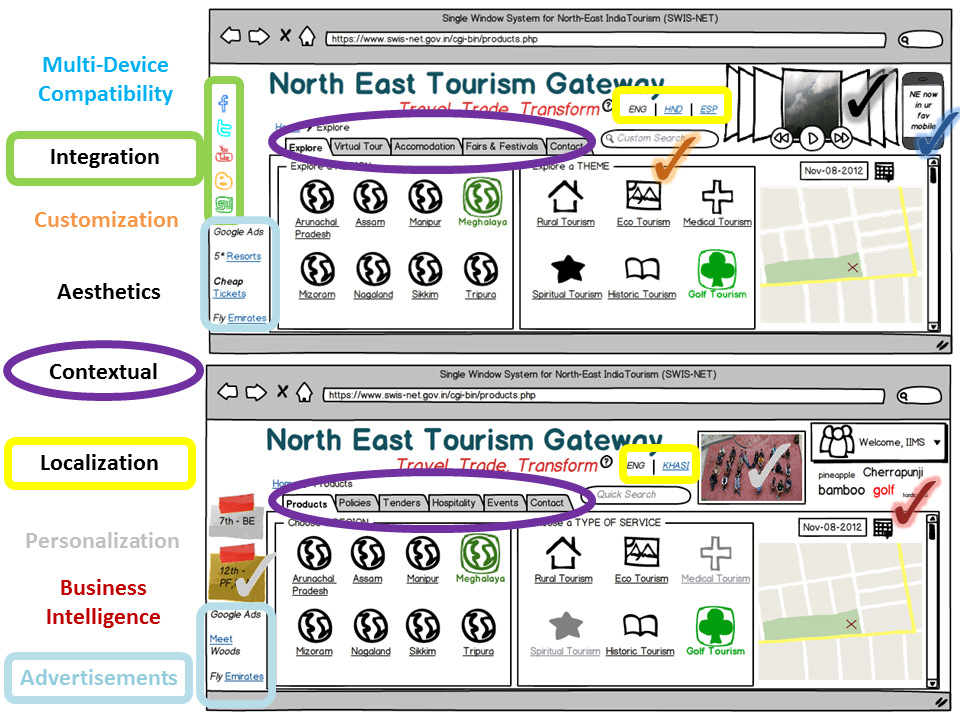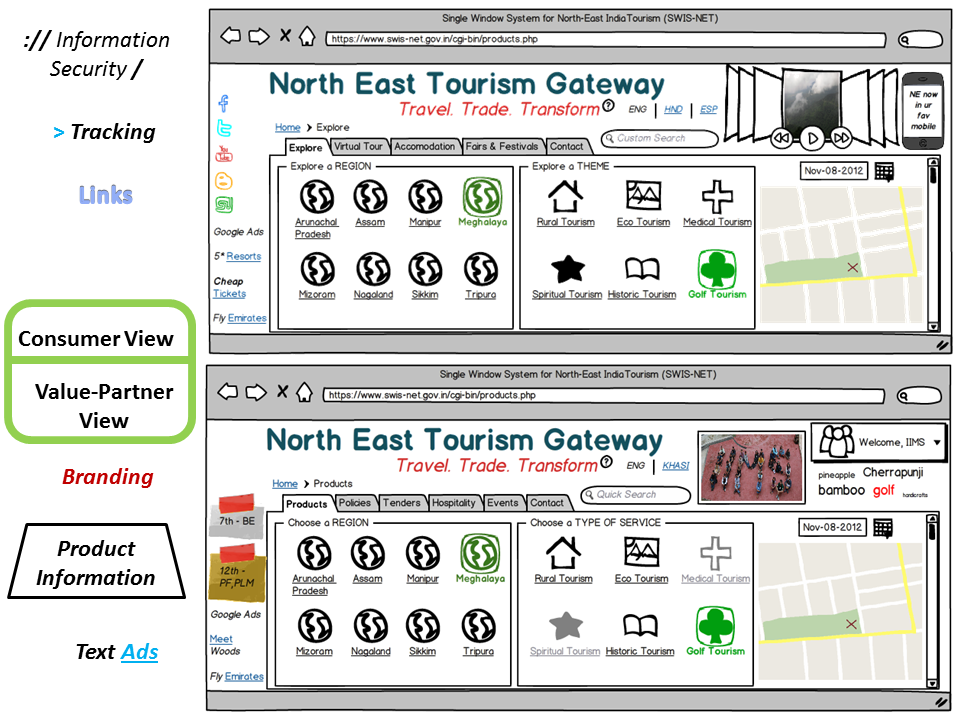Internet is the current one-stop shop for all our information needs. Interested people can have a look at its details and history. For others, a succinct summary about 'what is internet?' is captured in below animation.
 |
| What is Internet? |
Why internet?
The reasons for using internet for business activities are not hard to see. Though they can be many fold, there are only two dimensions of focus; the source - demand/supply and the sink - opportunities/risks.
The reasons for using internet for business activities are not hard to see. Though they can be many fold, there are only two dimensions of focus; the source - demand/supply and the sink - opportunities/risks.
In
terms of supply-side opportunities, fewer organizations have taken full
advantage of this giant of the medium and hence it provides an excellent
incentive to be a pioneer in one's respective industry. Also, the entry
barrier is quite low when compared to other traditional media.
Organizations can generate ideas for designing their new
products/services, receive immediate feedback from customers about their
performance, take measures to improve their service quality, reduce the
transaction costs, inventory, response time etc. The list is endless.
Regarding
demand-side opportunities, sellers should be where buyers would be.
Internet is growing to be the hottest channel for shopping and
e-commerce is where the money lies. Examples of organizations that are
milking these opportunities are abound - eBay, amazon, flipkart etc.
However, business is not just about utilizing opportunities - it is also about reducing risks. The supply-side suffers from inertia risk - the risk of being left out and innovation risk - the risk of becoming obsolete. The supply risk also includes performance risks
- in terms of cost, time and quality of products/services offered.The demand-side
risks or the demand uncertainties are widely known and were carefully studied
in many forums before.Internet is not just another medium. In fact, it is the most powerful medium there is currently. A Chief Marketing Officer (CMO) can lever on this power to design and implement his strategic marketing and marketing strategy plans.
The way forward is simple. Information is the bloodline of business and internet is going to rule the world as the primary source of information in near future. So, marry marketing and information domains of the organization. A recent HBR article recommends exactly that.
Some advantages of using internet are - speed, efficiency, targeting and positioning capabilities, message customization, customer interaction, access to vital information and importantly, improved sales potential.
How? - An action plan
To synergize the marketing and IT functions, the top management should evolve a plan of integrated communication and drive a top-down approach. The roadmap for the same is given below.
Target Audience --> Objectives --> Strategies --> Measurement
Target market
·
B2C market
- Consumers are “money rich and time poor”
- Demographic profile is skewed towards higher education and income levels
- Net usage mainly for searching information about products, services and for shopping
- Internet – the future leading cause of consumer spending
·
B2B market
- Market size dwarfs B2C market
- Leading segments: Products - Electronics, Computing, Distribution - Shipping, Warehousing, Utilities
For a visionary CMO looking at internet as the gold mine of opportunities, following would be the objectives of his strategic marketing plans.
Primary Objective
- Develop internet as the universal medium - from information dissemination to whole spectrum of marketing mix
- Build interactive capabilities - from read-only web to read-write web (Web 2.0)
- Develop a platform for relationship building - across stakeholders
- Extract maximum out of this hybrid media
- Product
- Understand the pulse of customers with feedback mechanism
- Extract ideas about future products/services requirements
- Design products based on near-real-time consumer needs/wants information, even for mass market
- Price
- Decide on the optimal pricing
- Promotions
- Create awareness about products, services offered and their UVP
- Generate interest among potential customers - develop the pull factor
- Disseminate information to the target market - effectively, efficiently and economically
- Build a strong brand image
- Place
- Stimulate trials, a decisive element in consumers' purchase process
- Convert potential customers to actual customers through buying options (e-commerce)
Advertising
Some of the common form of advertising strategies are given below-
- Banner Ads - Advertisements in the form of banners
- Sponsorships - Ownership of an entire site or page
- Pop-ups/Pop-unders - A separate, small window that appears automatically
- Interstitials - Advertisements that appear while the page loads
- Webcasting - A push technology, automated delivery of messages
- Links - Hypertext links to other pages, including external sites
- Text Ads - No frill advertisements, based on relevancy of user interaction
Following video details the various strategies and tactics in online advertising.
Integration
Integration is the big story in every company's backyard. This integration is within the organization (through intranet) and also across the value-chain (including extranet). Some examples of integrated communication using internet are - Sales promotion, Personal selling, Public Relations, Direct marketing (Direct mail, Informercials, e-commerce, Home shopping channels)
Some ways to measure the effectiveness of internet based integrated communications/marketing strategies are tracking - a measure on the performance of the site, recall and retention - a measure critical to marketing communications, typically done through personalized approaches like feedback, ratings etc., non-response - measure of failures, surveys - either online or through offline modes and sales - volume and value of sales generated through sites.
The key terms typically used in these measurements, which also affects the costing/revenue model, are hits - number of requests for a site content, viewers - visits/site, unique visitors - distinct visitors to the site in the observed time frame, click-throughs - number of visitors clicking on banner ads, click-through rate, impressions per page view - number of times viewers view the page.
What's the catch?
- Higher cost
- Unreliable measurements and statistics
- Lower internet penetration in the developing countries and hence limited reach
Consider an organization wanting to develop a single-window online system for tourism, specific to North-eastern states of India.
The target market, here, is geography-based in terms of supply and boundary-less in terms of demand. The primary target segment are travelers/tourists i.e. the B2C segment; however, the secondary B2B segment, in terms of service providers, are also within the purview of portal's service.
The online portal website, thus designed, can be evaluated based on 5C model - Context, Content, Credential, Clarity and Communication.
Alternatively, detailed evaluation criteria for website evaluation can be used.
Following snapshots show the aspects and features of the portal website.
 |
| Design of the new portal website |
 |
| Evaluation of the Portal Website |
In essence, the internet is a Strategic Marketing Tool
- It is not just another medium of communication
- It provides a platform for integrated marketing solutions
- It is most effective when used in conjunction with other marketing programs
- It is a very powerful tool in the hands of a strategist


banner advertisements
ReplyDeleteThis is spectacular! Simply put i appreciate reading your written content everytime I get feed alarm.